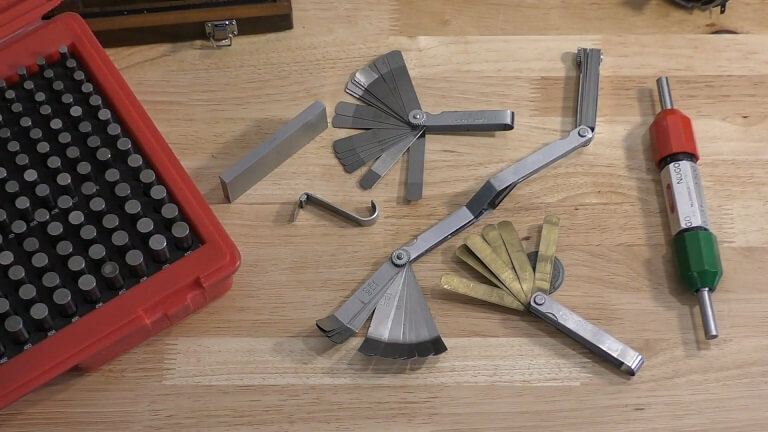A feeler gauge is a simple yet essential tool used to measure gaps and clearances precisely. Made up of thin, flat metal blades of varying thickness, feeler gauges help ensure that parts fit together correctly in machines, engines, and other applications whether you’re checking the distance between engine components or ensuring a perfect fit in metalworking.
This handy tool provides accurate measurements that are crucial for proper functioning. Using a feeler gauge is straightforward: just insert the appropriate blade into the gap you want to measure. Understanding how to use a feeler gauge can improve your work quality, whether you’re a mechanic, engineer, or DIY enthusiast.
What is a Feeler Gauge?
A feeler gauge is a precision tool used to measure gaps or clearances between two parts. It consists of a set of thin, flat metal blades, each with a specific thickness, often ranging from 0.001 inches to several millimeters.
Key Features:
- Material: Typically made from stainless steel or brass for durability.
- Sizes: Comes in various thicknesses, allowing for a wide range of measurements.
- Flexibility: The blades can be easily inserted into tight spaces to assess gaps accurately.
Uses:
- Automotive: Commonly used to check valve clearances in engines.
- Manufacturing: Useful for ensuring proper fit in machinery and components.
- DIY Projects: Helpful for hobbyists in model building and home repairs.
Overall, feeler gauges are essential for anyone needing precise measurements in their work.
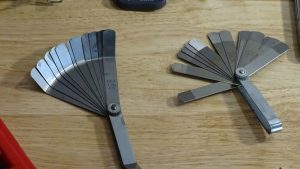
How Do You Use a Feeler Gauge?
Using a feeler gauge is straightforward. Here’s a step-by-step guide to help you measure gaps accurately:
Step 1: Gather Your Tools
- Feeler Gauge Set: Make sure you have a complete set with various thicknesses.
- Clean the Area: Ensure the surfaces you’ll be measuring are clean and free of debris.
Step 2: Select the Correct Blade
- Choose the Right Thickness: Based on the gap you need to measure, select a blade that closely matches the expected clearance.
Step 3: Insert the Feeler Gauge
- Insert the Blade: Carefully insert the selected blade into the gap you want to measure. If it fits snugly, you’ve found the correct thickness. If it’s too loose, try a thicker gauge; if it’s too tight, go for a thinner one.
Step 4: Check for Fit
- Determine Accuracy: If the gauge slides in with slight resistance, you’ve likely found the right size. If it’s difficult to insert, choose a thinner blade.
Step 5: Record the Measurement
- Take Note: Once you’ve identified the correct thickness, record the measurement for reference.
Step 6: Repeat if Necessary
- Double-Check: If precision is critical, repeat the process with a few different blades to confirm your measurement.
Tips for Accurate Measurements
- Use a Steady Hand: Keep the feeler gauge straight as you insert it to avoid misreading.
- Avoid Force: Do not force the gauge into the gap; this can lead to inaccurate measurements or damage.
You can effectively use a feeler gauge to measure clearances and gaps in various applications.
Applications of Feeler Gauges
Feeler gauges are versatile tools used in numerous applications across various industries. Here are some key applications:
1. Automotive Industry
- Valve Clearance Measurement: Essential for checking the space between engine components to ensure optimal performance.
- Spark Plug Gaps: Used to adjust the gap between spark plug electrodes, crucial for efficient ignition.
2. Manufacturing
- Machinery Alignment: Helps measure gaps in machinery parts, ensuring accurate alignment for smooth operation.
- Quality Control: Checks tolerances in manufactured components to ensure they meet specifications.
3. Engineering
- Assembly Precision: Assists in verifying the fit of components in mechanical assemblies, ensuring proper function.
- Tool Setup: Measures gaps in fixtures and tools to maintain desired tolerances during production.
4. Hobbies and DIY Projects
- Model Building: Useful for ensuring precise fits in model kits and other crafts.
- Woodworking: Helps measure gaps for joints and fittings to achieve a snug fit.
5. Aerospace
- Component Inspection: Ensures gaps and clearances meet strict safety standards in aircraft assembly.
6. Plumbing
- Pipe Fitting: Measures gaps between pipes and fittings to verify proper connections.
7. Electronics
- Circuit Board Assembly: Checks spacing between components to prevent short circuits and ensure reliability.
8. Construction
- Gap Measurement: Useful for measuring gaps in framing and installations to ensure structural integrity.
These applications demonstrate the critical role feeler gauges play in maintaining precision and quality across various fields.
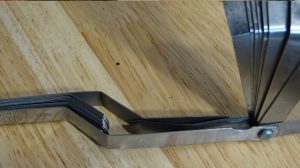
Choosing the Right Feeler Gauge
Choosing the right feeler gauge is crucial for achieving accurate measurements in your projects. Here are some key factors to consider:
1. Thickness Range
- Variety of Sizes: Look for a feeler gauge set that includes a wide range of thicknesses, typically from 0.001 inches (0.025 mm) to several millimeters. This variety allows you to measure various gaps accurately.
2. Material
- Durability: Most feeler gauges are made from stainless steel, which resists rust and wear. Brass is another option, offering good flexibility but may not be as durable.
- Flexible vs. Rigid: Choose a gauge that balances flexibility and rigidity based on your specific needs. Flexible blades can fit into tighter spaces.
3. Measurement Units
- Imperial vs. Metric: Decide whether you need measurements in inches or millimeters. Some sets offer both, which can be useful for different applications.
4. Ease of Use
- Handle Design: Some feeler gauge sets come with handles or clips for easier handling and storage. This can be particularly useful for repetitive measurements.
- Marked Thickness: Ensure the thickness of each blade is clearly marked for quick identification.
5. Calibration
- Precision: If you’re working in a highly precise environment, consider a calibrated set. This ensures that the measurements are accurate and reliable.
6. Brand and Quality
- Reputable Brands: Opt for well-known brands with a reputation for quality. This often translates to better durability and accuracy.
7. Cost
- Budget: While it’s important to invest in quality, there are feeler gauge sets available at various price points. Find a balance between affordability and quality.
You can select the right feeler gauge that meets your specific measurement needs, ensuring accuracy and reliability in your work.
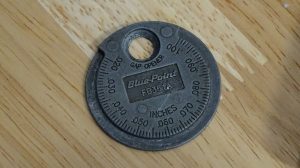
Best Practices for Storing Feeler Gauges
Proper storage of feeler gauges is essential for maintaining their accuracy and longevity. Here are some best practices:
1. Use a Protective Case
- Storage Case: Keep your feeler gauges in a dedicated storage case or pouch. This protects them from dust, moisture, and physical damage.
2. Keep Them Organized
- Labeling: If your set includes various thicknesses, consider using a labeled case or holder to quickly identify the blades you need.
- Order by Size: Store the blades in order of thickness for easy access.
3. Avoid Moisture
- Dry Environment: Store your feeler gauges in a dry place to prevent rust and corrosion. Consider using silica gel packs to absorb moisture in enclosed storage.
4. Handle with Care
- Gentle Handling: When inserting or removing blades, handle them gently to avoid bending or damaging them.
5. Regular Inspection
- Check for Wear: Periodically inspect your feeler gauges for signs of wear or damage. Replace any that are bent or significantly worn.
6. Avoid Extreme Temperatures
- Stable Temperature: Store gauges in a location with stable temperatures, avoiding areas that experience extreme heat or cold.
7. Keep Away from Chemicals
- Chemical Exposure: Avoid storing feeler gauges near chemicals or solvents that could corrode the metal.
You can ensure by these best practices that your feeler gauges remain accurate and in good condition for years to come.
Cleaning Methods to Ensure the Longevity of Feeler Gauge
Here are some effective cleaning methods:
1. Wipe with a Dry Cloth
- Basic Cleaning: After each use, wipe the blades with a clean, dry cloth to remove dirt, oil, and moisture.
2. Use a Mild Solvent
- For Stubborn Residue: If there are stubborn residues, use a mild solvent (like isopropyl alcohol) on a soft cloth. Avoid harsh chemicals that could corrode the metal.
3. Brush with a Soft Brush
- Dust Removal: Use a soft brush to gently remove dust and debris from the blades, especially in hard-to-reach areas.
4. Avoid Abrasives
- No Abrasive Materials: Do not use abrasive pads or materials that can scratch or damage the surface of the blades.
5. Dry Thoroughly
- Prevent Rust: After cleaning, ensure the blades are completely dry before storing them to prevent moisture buildup and rust.
6. Apply a Light Oil
- Protection Against Corrosion: Consider applying a thin layer of light machine oil to the blades after cleaning. This provides a protective barrier against moisture and corrosion.
7. Regular Inspections
- Check for Damage: Regularly inspect your feeler gauges for signs of wear, rust, or damage. Clean as needed to maintain their condition.
These cleaning methods can help ensure that your feeler gauges remain accurate and in excellent condition for a long time.
Signs of Wear and When to Replace of Feeler Gauge
Recognizing signs of wear on feeler gauges is crucial for maintaining accuracy and ensuring reliable measurements. Here are some common signs of wear and guidelines on when to replace them:
Signs of Wear
- Bending or Warping
- If the blades are visibly bent or warped, they can no longer provide accurate measurements.
- Rust or Corrosion
- Any signs of rust or corrosion on the blades can compromise their integrity and accuracy.
- Chips or Nicks
- Inspect the edges of the blades for chips or nicks, which can affect their ability to fit properly into gaps.
- Worn Markings
- If the thickness markings on the blades are fading or illegible, it can lead to measurement errors.
- Difficulty in Insertion
- If the blades are difficult to insert into gaps they previously fit into, this could indicate wear or damage.
- Inconsistent Measurements
- If you notice discrepancies in measurements when using the same gauge, it may be time for replacement.
When to Replace
- Bending or Major Damage: Replace immediately if blades are bent, chipped, or warped.
- Significant Rust or Corrosion: If rust cannot be removed effectively or affects usability, replace the gauge.
- Frequent Inaccuracies: If you often find yourself questioning the accuracy of measurements, consider replacing the entire set.
- General Wear: For regular users, consider replacing feeler gauges every few years, depending on usage frequency and care.
With these signs of wear and replacing gauges as needed, you can ensure consistent accuracy in your measurements.
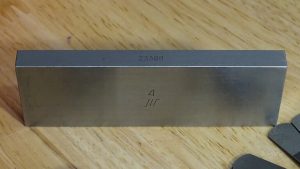
Common Mistakes to Avoid of Feeler Gauge
When using a feeler gauge, avoiding common mistakes is essential for achieving accurate measurements. Here are some pitfalls to watch out for:
1. Using the Wrong Thickness
- Mistake: Selecting a blade thickness that doesn’t match the gap being measured.
- Tip: Always start with a thicker gauge and work down to find the one that fits snugly.
2. Forcing the Blade
- Mistake: Applying excessive force when inserting the gauge into a gap.
- Tip: The blade should slide in with slight resistance. If it’s too tight, choose a thinner blade.
3. Neglecting to Clean the Surfaces
- Mistake: Measuring on dirty or oily surfaces, can lead to inaccurate readings.
- Tip: Always ensure that both the gauge and the surfaces being measured are clean.
4. Not Checking for Wear
- Mistake: Using worn or damaged blades without checking their condition.
- Tip: Regularly inspect your gauges for bends, rust, or nicks, and replace them if necessary.
5. Misreading the Measurement
- Mistake: Incorrectly interpreting the size of the gauge being used.
- Tip: Ensure the thickness is clearly marked and double-check before recording measurements.
6. Using in the Wrong Environment
- Mistake: Measuring in extreme temperatures or humid conditions.
- Tip: Store and use feeler gauges in stable environments to maintain their integrity.
7. Improper Storage
- Mistake: Storing gauges in a way that causes them to bend or get damaged.
- Tip: Use a protective case and store them flat to avoid distortion.
8. Ignoring Calibration Needs
- Mistake: Assuming all feeler gauges are accurate without calibration.
- Tip: For critical applications, consider using calibrated gauges and regularly check their accuracy.
These common mistakes by avoiding, you can ensure that your feeler gauge provides reliable and precise measurements every time.
In conclusion
Feeler gauges are valuable tools that help you measure small gaps and clearances accurately. They are widely used in various fields, including automotive work, manufacturing, and DIY projects. By learning how to use them correctly and taking care of them, you can ensure they last a long time and provide reliable measurements.
Remember to choose the right thickness for your needs and avoid common mistakes to get the best results. Whether you’re a professional or a hobbyist, mastering feeler gauges can significantly improve the quality of your work.

